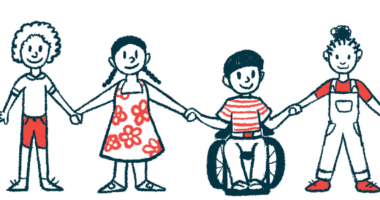Surgery can relieve Pompe disease children’s drooping eyelids: Report
CFS suspension is a surgical technique that involves attaching connective tissue

A surgical technique called conjoint fascial sheath (CFS) suspension may help relieve drooping eyelids in children with infantile-onset Pompe disease (IOPD).
“Surgical correction may provide a practical option for ptosis [drooping eyelid] correction in patients with IOPD,” the researchers wrote in “Blepharoptosis in infantile onset Pompe disease: Histological findings and surgical outcomes,” which was published in Molecular Genetics and Metabolism Reports.
In Pompe disease, mutations in the GAA gene result in the acid alpha-glucosidase enzyme being absent or poorly functioning. This causes glycogen to build up in tissues and causes damage — especially to muscles.
A feature of IOPD is muscle weakness in the face and tongue, which leads to poor feeding and slower growth. Delayed motor development, difficulty breathing, respiratory infections, and hearing loss are also observed. Cardiomyopathy, heart muscle disease, is common in this type of Pompe disease too.
Children with IOPD are now living longer than they ever have before, thanks to advances in treatment, but as they age many still have disease-related health problems, such as ptosis, when the eyelids droop down over the eye. This can cause issues with vision.
A procedure called levator muscle resection, or LR, is commonly performed to correct ptosis. It involves shortening a muscle that holds up the eyelid so it’s easier to keep it raised. Ptosis can recur in IOPD patients even after surgery however.
CFS suspension is a more recently developed technique that involves attaching connective tissue, thereby avoiding having to manipulate muscle.
A new technique for drooping eyelids in Pompe disease
Scientists in Taiwan reported on outcomes for six children with IOPD who had surgery for ptosis at their center. The children ranged in age from 4 to 11 at the time of surgery and all but one had ptosis in both eyes.
Four of the children had had LR, and that, along with an increase in dosage of enzyme replacement therapy, was sufficient to relieve ptosis in one of them. Ptosis recurred in the others, however, prompting a second surgery to administer CSF suspension.
The other two children underwent a procedure that combined LR and CSF suspension right away. For both, this was effective for relieving ptosis without further treatment, though one had a second cosmetic surgery to get better eyelid symmetry.
“After treatment with combined LR and CFS suspension, ptosis did not recur in any of the studied cases,” the researchers said.
Up to the last clinical visit, the surgery prevented the recurrence of strabismus — when the eyes don’t line up with one another — among the two patients with this condition.
“This is the first study to apply CFS suspension as an adjuvant to LR for ptosis correction in IOPD cases, and the long-term results are better than those of the traditional LR-only technique,” said the researchers, who noted the study was limited by its size, largely a reflection of the rarity of Pompe disease. They said more research should be done to improve eye-related care in Pompe.
As part of the procedures, the researchers collected and analyzed samples of eye muscles from the children. They found the levator muscle, which is mainly responsible for holding up the eyes, tended to have glycogen accumulation in these patients, whereas other eye muscles had less. This may partially explain why ptosis is more common in IOPD than other eye issues like strabismus, they said.







